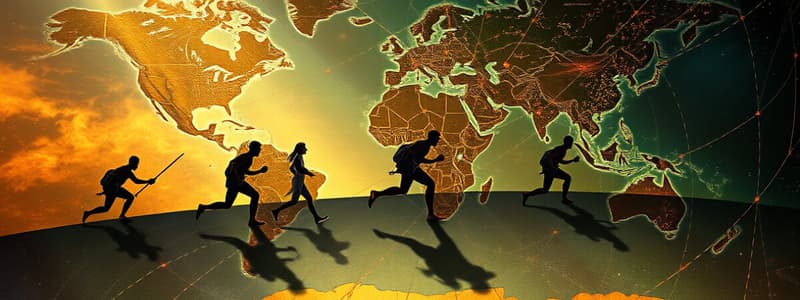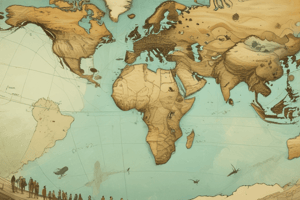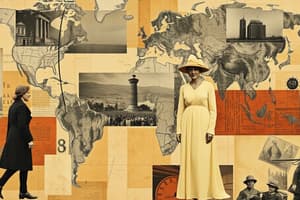Podcast
Questions and Answers
What are two positive impacts of migration on the home countries of migrants?
What are two positive impacts of migration on the home countries of migrants?
Migrants send earnings back to home countries, improving economic growth, and they return with new skills and knowledge.
Explain how brain drain negatively affects the standard of living in developing countries.
Explain how brain drain negatively affects the standard of living in developing countries.
Brain drain leads to huge economic losses, which affect employment and wage rates, resulting in a decline in the standard of living.
In what way can migration contribute to the development of job opportunities in developing countries?
In what way can migration contribute to the development of job opportunities in developing countries?
Migration can improve education and skill accessibility, creating more job opportunities for the local population.
What role do remittances play in the economic growth of migrants' home countries?
What role do remittances play in the economic growth of migrants' home countries?
Identify one way the loss of professionals due to migration impacts the industries in the home country.
Identify one way the loss of professionals due to migration impacts the industries in the home country.
What is the main difference between immigration and emigration?
What is the main difference between immigration and emigration?
Identify two reasons why people may choose to migrate.
Identify two reasons why people may choose to migrate.
What historical evidence supports the idea of migration in human history?
What historical evidence supports the idea of migration in human history?
How did the Industrial Revolution impact human migration patterns?
How did the Industrial Revolution impact human migration patterns?
Explain the importance of migrants in modern states.
Explain the importance of migrants in modern states.
What are push and pull factors in the context of migration?
What are push and pull factors in the context of migration?
Which regions did many European migrants move to during the late 19th and early 20th centuries?
Which regions did many European migrants move to during the late 19th and early 20th centuries?
What role do modern transportation and communication play in migration today?
What role do modern transportation and communication play in migration today?
What are the main economic push factors that lead people to migrate?
What are the main economic push factors that lead people to migrate?
Name two pull factors related to social migration.
Name two pull factors related to social migration.
What is forced migration and give an example?
What is forced migration and give an example?
Differentiate between intercontinental migration and intracontinental migration.
Differentiate between intercontinental migration and intracontinental migration.
Explain what rural-urban migration is.
Explain what rural-urban migration is.
What defines impelled migration?
What defines impelled migration?
What are the characteristics of seasonal migration?
What are the characteristics of seasonal migration?
What is the impact of migration on the destination country's economy?
What is the impact of migration on the destination country's economy?
Identify one social impact of migration.
Identify one social impact of migration.
What does return migration refer to?
What does return migration refer to?
Define urban-urban migration.
Define urban-urban migration.
What are the demographic impacts of migration?
What are the demographic impacts of migration?
List one negative social impact of migration.
List one negative social impact of migration.
What motivates urban-rural migration?
What motivates urban-rural migration?
What are two positive economic impacts of immigration?
What are two positive economic impacts of immigration?
Name one demographic impact of immigration that could be considered negative.
Name one demographic impact of immigration that could be considered negative.
How can immigration positively affect foreign relations?
How can immigration positively affect foreign relations?
What environmental concern arises from increased immigration?
What environmental concern arises from increased immigration?
How does brain drain affect the source country's economy?
How does brain drain affect the source country's economy?
What is one positive social impact of immigration on the source country?
What is one positive social impact of immigration on the source country?
Identify a pull factor contributing to brain drain.
Identify a pull factor contributing to brain drain.
What demographic advantage does immigration provide to the host country?
What demographic advantage does immigration provide to the host country?
What negative social impact can result from immigration?
What negative social impact can result from immigration?
Explain how brain drain is characterized by skilled migration.
Explain how brain drain is characterized by skilled migration.
What is a negative environmental impact of transportation related to migration?
What is a negative environmental impact of transportation related to migration?
How can less skilled workers contribute negatively to migration?
How can less skilled workers contribute negatively to migration?
What is one cause of brain drain related to educational opportunities?
What is one cause of brain drain related to educational opportunities?
What is one impact on the local population when immigrants reside in a country?
What is one impact on the local population when immigrants reside in a country?
Flashcards are hidden until you start studying
Study Notes
Understanding Human Migration
- Human migration involves moving from a permanent residence to another location for an extended period.
- Types of migration:
- International migration: Movement between countries.
- Internal migration: Movement within a country, often from rural to urban areas.
Historical Context
- Migration has been a part of human existence, with records of people moving long distances, such as migrations from Asia to the Americas via the Bering Strait.
- During the Industrial Revolution, over 50 million people moved from Europe to the Americas and other regions, often to escape poverty and crop failures.
Current Trends in Migration
- Migration rates today are the highest in history, driven by:
- Improved transportation and communication.
- Pursuit of better living standards and opportunities.
- Escape from poverty, conflict, and famine.
Immigration vs. Emigration
- Immigration: Moving to live permanently in another country.
- Emigration: Leaving one’s home country to live in another.
- Both processes are linked but differ in direction.
Reasons for Migration
- Push Factors: Conditions that drive individuals away from their origin.
- Examples: Overpopulation, economic hardship, political instability.
- Pull Factors: Attractions of the destination.
- Examples: Better job opportunities, educational prospects, religious freedom.
Types of Migration
- Intercontinental Migration: Movement between continents.
- Intracontinental Migration: Movement within the same continent.
- Rural-Urban Migration: People moving from rural areas to cities for opportunities.
- Forced Migration: Government coerces individuals to move (e.g., refugees).
- Seasonal Migration: Temporary movement based on seasonal work.
- Return Migration: Migrants returning to their original location after a period.
- Interstate Migration: Movement between states within a country, common in nations with favorable laws.
Impacts of Migration
On Destination Countries
- Social/Cultural:
- Positive: Introduction of diverse cultures; skilled labor.
- Negative: Cultural clashes; increased housing demand; potential for higher crime rates.
- Economic:
- Positive: Tax revenue increase; economic growth; filling labor shortages.
- Negative: Lack of flexibility in labor; remittances sent home.
- Demographic:
- Positive: Reduced dependency ratios; population growth.
- Negative: Overcrowding; skewed sex ratios.
- Political:
- Positive: Improved international relations and services for immigrants.
- Negative: Potential for conflict and increased social demands.
- Environmental:
- Negative: Strain on resources and increased pollution from increased populations.
On Source Countries
- Social/Cultural:
- Positive: Cultural exchange; improved professional options.
- Negative: Family separations and associated issues.
- Economic:
- Positive: Remittances support the economy; skill transfer upon return.
- Negative: Loss of skilled workforce; reliance on foreign talent.
- Demographic:
- Positive: Balanced population structure; slowed growth.
- Negative: Slower development due to emigration of skilled workers.
- Environmental:
- Positive: Reduced resource strain; lower pollution levels.
- Negative: Environmental impact of migration processes.
Brain Drain Phenomenon
- Describes the emigration of a country’s educated and skilled professionals to more developed regions.
- Characteristics:
- High movement from developing to developed nations.
- Essential skills often migrate for better opportunities.
- Push Factors: Poor job prospects, low wages, political instability.
- Pull Factors: Competitive wages, stable political climates, improved education systems.
Brain Drain in India
- Many professionals such as doctors and engineers migrate to countries like the USA and Canada, leading to skill loss in India.
- Despite brain drain, India's economy has seen improvement due to increased educational and job opportunities.
Impacts of Brain Drain
- Positive:
- Revenue generation through remittances; skill acquisition upon return.
- Improved living standards for families of migrants.
- Negative:
- Economic decline; slow industry growth; loss of investment in education.
Studying That Suits You
Use AI to generate personalized quizzes and flashcards to suit your learning preferences.




